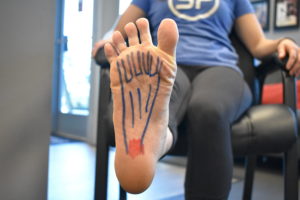
Over the past week I have had numerous clients tell me that they have been using a heating pad on a new injury, like a freshly sprained ankle. I have also had a lot of clients ask me, “what should I use? Is ice or heat better for me?” These conversations made me realize that educating clients on the proper use of heat and cold is very important. It is an important factor when considering the healing process and timeframe. Let me preface all of this by saying there is some debate on how to use heat and cold for our aches and injuries. There is not a single “best” way to use these two modalities; however the following 4 tips are to provide you with a generalized understanding and overall guideline.
1. Acute vs. Chronic – as a general rule, ice is used for acute injuries and heat is used for chronic pain. Acute injuries are defined as an injury that has occured within the last 48 hours and a chronic injury has been present for 6 weeks or more. In an acute injury, swelling is typically present and ice is used to decrease the swelling by stopping blood flow to the area. In a chronic injury, swelling is no longer present but we are still feeling some type of pain in our muscles. This is why we use heat, because it brings blood flow to the area and helps the muscles relax. If you are experiencing a new injury with notable swelling, heat should be avoided for at least 2 weeks. There will come a time in your healing process where you may not be experiencing relief anymore with whichever temperature you were using. If this is the case and no swelling is present, then it is okay to try the other form or alternate between the two to find which works better for you.
2. Relaxing vs. Numbing – if there is not a new injury present, than you can use this question to help determine whether to use ice or heat: do you want to relax your muscles and ease tightness, or do you want to numb the pain altogether? Heat is typically better used for relaxing stiff, tight muscles and ease any type of muscle ache. Whereas ice is better in situations where there is an injury that needs to be calmed down and numbed. Think of it this way, heat helps with relaxation and ice temporarily numbs the nerves to decrease pain.
3. Muscle vs. Joint – this is another easy way to decide if you should use heat or ice. First, figure out what is bothering you. Is it your hamstring? Is it your low back? Is it your actual knee or ankle joint? If you are having discomfort directly in the muscle, heat should be used to help relax the muscles and decrease pain. If you are feeling pain in the actual joint, like your ankle or your knee, ice can be helpful to numb the pain and reduce any swelling not visible because it is inside the joint. A tricky area to think about is the low back, but typically pain in the low back area is muscle related and responds well to heat, unless it is a new injury or post-surgical.
4. Frequency & Duration – there IS such a thing as using heat and/or ice for too long or too much. One key point to remember is that you never want to put ice or heat directly on the skin, there needs to be some sort of barrier (i.e. a towel & piece of clothing, etc). There are certain some methods where direct skin contact is acceptable but you should consult with your trusted medical provider first. It is typical to use ice and/or heat for 10-20 minutes 1-2 times a day when necessary. Heat can be used before activity to warm-up the muscles, while ice can be used after activity as a preventative measure.
I hope these 4 tips answer any questions or hesitations you may have about using heat and/or ice. But remember, there is not a “best way” and you do not want to be solely reliant on ice/heat to prevent injury or ease your pain. If you have any questions or concerns about how to use heat and/or ice, consult with your medical provider first.
-Dr. Melanie

STAY CONNECTED
Instagram: CLICK HERE
Facebook: CLICK HERE
YouTube: CLICK HERE
Podcast: CLICK HERE
TUNE IN TO OUR PODCAST












